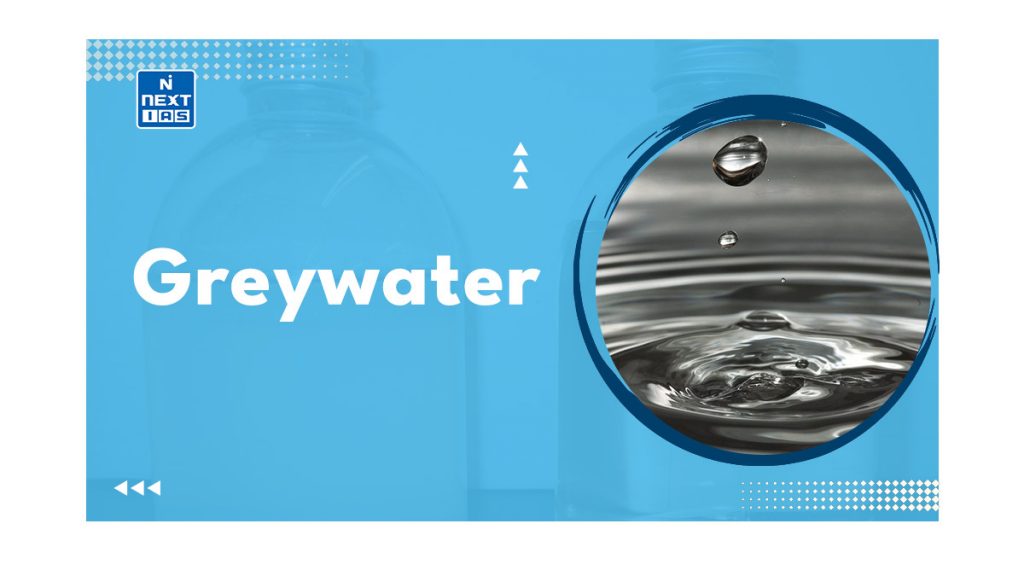
Greywater, also known as sullage, refers to household or office wastewater generated from sources other than toilets, without fecal contamination. This article aims to provide a comprehensive overview of Greywater and its meaning, treatment, benefits & challenges.
As per World Health Organisation (WHO), Domestic wastewater, or “sewage”, can be divided into two categories:
- blackwater which originates from toilets and kitchens has gross faecal coliform contamination and generally has high concentrations of organic matter;
- and greywater which originates from bathrooms and laundries and constitutes the largest flow of wastewater.
What is Greywater?
The term “greywater” refers to untreated household wastewater, which has not been contaminated by toilet waste.
It is called greywater because if stored for even short periods of time, the water will often cloud and turn grey in colour. The exact sources of greywater vary according to countries and organizations. Some definitions include the water sourced from the kitchen and dishwasher.
It includes water from sinks, showers, baths, washing machines, and dishwashers. It is relatively safer to handle and easier to treat compared to blackwater (wastewater from toilets) because it contains fewer pathogens. It can be reused onsite for various non-potable purposes such as toilet flushing, and landscape or crop irrigation.
- It is essential to note that this water is not entirely free of pathogens, as it may contain traces of human waste from laundering soiled clothing.
- The quality of Greywater can deteriorate during storage due to its warmth and the presence of nutrients, organic matter (e.g., dead skin cells), and pathogens, leading to potential odor nuisances.
- In a typical household with conventional flush toilets, this type of water constitutes about 65% of the total wastewater produced. Therefore, it can be a valuable source of water for reuse, especially for toilet flushing.
Process of Treatment of Greywater
To optimize the benefits of greywater reuse, it is advisable to separate it from toilet wastewater, as this significantly reduces the pathogen load and makes it easier to treat and recycle.
- Keeping it separate aligns with the concept of source separation in ecological sanitation approaches.
- Greywater from kitchen sinks often contains fats, oils, and grease, along with high loads of organic matter. Before discharging it into a tank, preliminary treatment should remove these substances.
- Compared to sewage, it is generally easier to treat and recycle due to lower levels of contaminants. Various treatment processes, often implemented at the household or building level, can purify greywater.
- These processes include biological systems like constructed wetlands and living walls, as well as mechanical systems such as sand filtration, lava filter systems, and UV radiation-based systems.
Benefits of Greywater Systems
The benefits of this type of water reuse are manifold. Some of them are enlisted here:
- Reduction in freshwater demand: By using it, the demand for fresh clean water is reduced, alleviating pressure on water supply systems.
- Ecologically viable: The volume of sewage effluent entering watercourses would be decreased, which can be ecologically beneficial.
- Helps water conservation: During droughts, this water can be used for irrigation or toilet systems, contributing to ecologically sustainable development by conserving water resources.
- Reduction in Groundwater Extraction: Potential ecological benefits of recycling include reduced freshwater extraction, less impact on septic tank and treatment plant infrastructure, reduced energy use and chemical pollution from treatment, groundwater recharge, and reclamation of nutrients.
- Helps Groundwater Recharge: The natural purification processes in the top layers of soil further improve the quality of surface and groundwater preserved through greywater recycling.
- Economics benefits: Its recycling holds significant potential economic benefits, including reduced demand for fresh water, leading to cost savings and less strain on global water resources.
- Suitable for Irrigation purposes: When used for irrigation, it appears to be safe, as shown by many epidemiological studies in arid regions. While some organic micropollutants may be present, their concentrations are generally low.
Challenges Associated with Greywater Usage in India
Its management in India faced several challenges due to the country’s vast population, rapid urbanization, and limited resources. These challenges include:
- Lack of Infrastructure: One of the major hurdles in this type of water management is the absence of adequate infrastructure for the collection, treatment, and reuse of greywater. Many urban and rural areas do not have proper sewage and drainage systems, leading to the direct discharge of this water into nearby water bodies, causing pollution and health hazards.
- Limited Awareness and Education: There is a lack of awareness among the general public about the importance of greywater management and its potential benefits. Many people are unaware of the risks associated with untreated water, as well as the possibilities for recycling and reusing it for non-potable purposes like irrigation and flushing.
- Financing and Investment: Implementing effective greywater management systems requires significant financial investments. Municipalities and local authorities often struggle to secure funding for the development and maintenance of such systems. The cost-effectiveness of greywater management projects is sometimes challenging to justify in the short term, which can deter potential investors and policymakers.
- Technological Challenges: In some regions, traditional water management practices are still prevalent, and adopting advanced technologies can be a challenge due to financial constraints and a lack of technical expertise. Simple and affordable technologies that suit the local context are needed to encourage widespread adoption.
- Water Quality Concerns: It can contain various pollutants, including chemicals, pathogens, and organic matter. If not treated properly, these contaminants can have adverse effects on the environment and public health. Implementing effective treatment methods to ensure the safe reuse or disposal of greywater is crucial.
- Behavioral Practices: Changing people’s behavior and habits related to water use and disposal can be difficult. Encouraging individuals and businesses to adopt water-saving practices and separate greywater from blackwater (sewage) requires awareness campaigns and community engagement.
- Intersectoral Coordination: Effective greywater management requires coordination between various sectors, including urban planning, water supply, sanitation, and agriculture. Integrating these sectors to create holistic water management plans can be challenging due to administrative complexities.
Conclusion
Due to a number of factors like increasing population, climate change, etc. the availability of water per person in India is going down drastically. To address these challenges, India needs a comprehensive and integrated approach that involves government support, public awareness campaigns, capacity building, and technological innovation in order to use grey.
Additionally, promoting research and development in sustainable and affordable greywater management technologies can go a long way in improving water conservation and reducing pollution in the country.
Frequently Asked Questions (FAQs)
What does Greywater mean?
It refers to domestic wastewater generated in households or office buildings from sources other than toilets. It includes water from sinks, showers, baths, washing machines, and dishwashers, excluding wastewater with fecal contamination.
What are the three types of Greywater Systems?
The three types of systems are:
a) Irrigation System: It is used for landscape or crop irrigation.
b) Indoor Reuse System: It is recycled for purposes like flushing toilets.
c) Clothes Washer System: Greywater from washing machines is reclaimed and used for irrigation.
What is the objective of Greywater Management?
The purpose of this overview is to provide guidance for local government officers, homeowners, site and soil evaluators, designers, installers and service technicians on the impacts of greywater reuse on human health, plants, animals and the environment.
In addition, this overview will focus on the reuse of greywater for domestic purposes without compromising public health; and on how to maintain and enhance the quality of the environment by setting minimum standards for the design and installation of greywater reuse systems to achieve the following:
– protection of groundwater
– protection of surface water
– protection of land and vegetation
– prevention of a public health risk
– protection of the community against possible disease transmission arising from improper greywater reuse and
– ensure that greywater installations do not harm the environment, or cause a nuisance, and are appropriately sited and maintained according to a regulatory standard.





